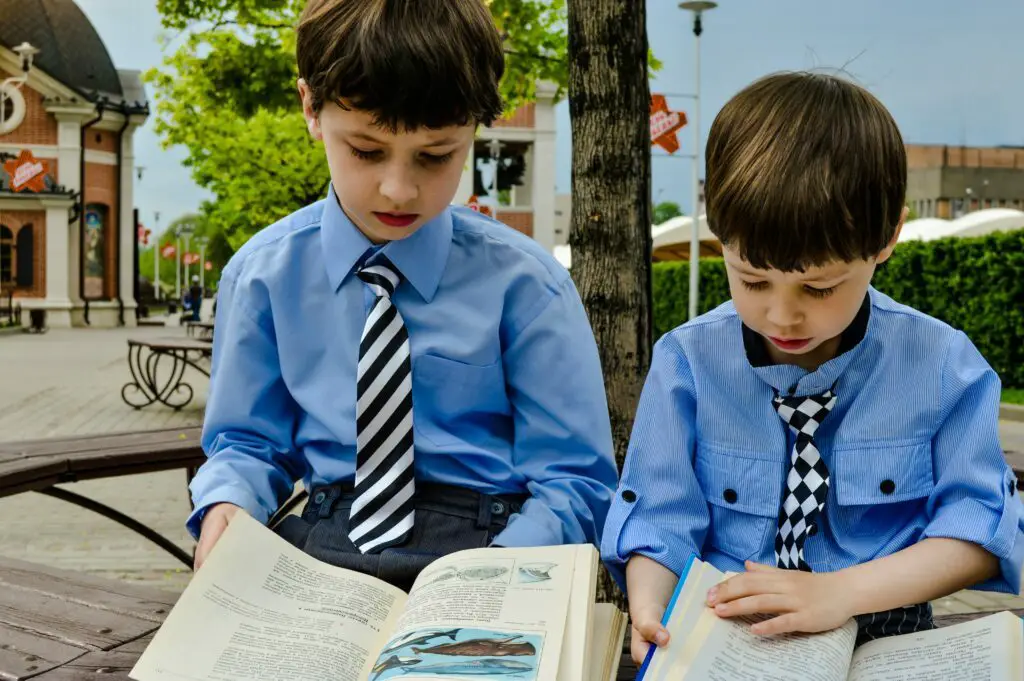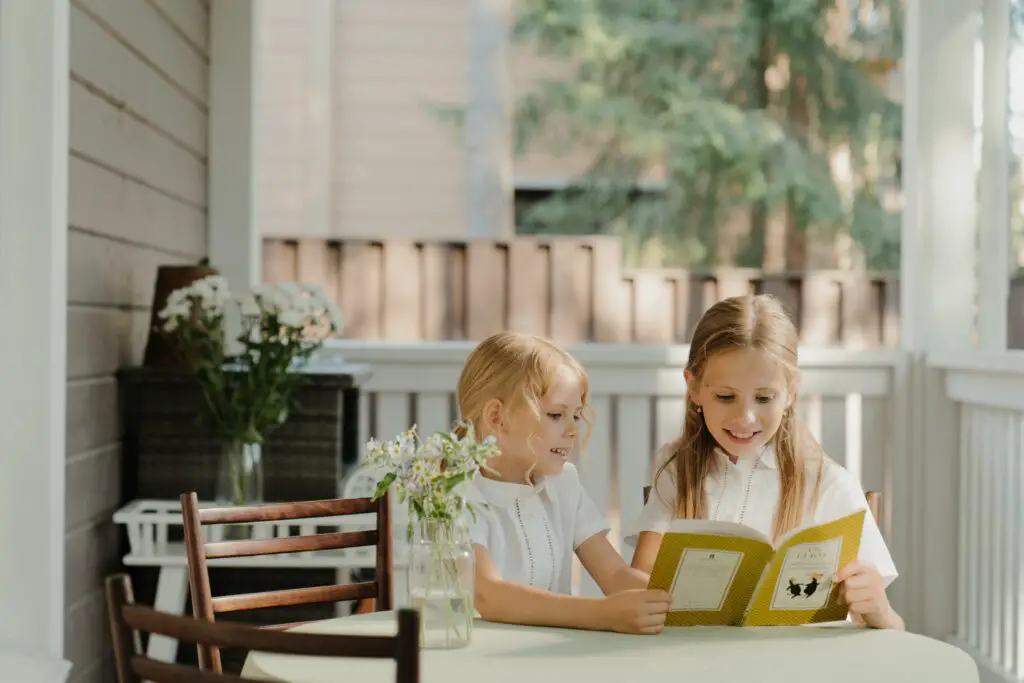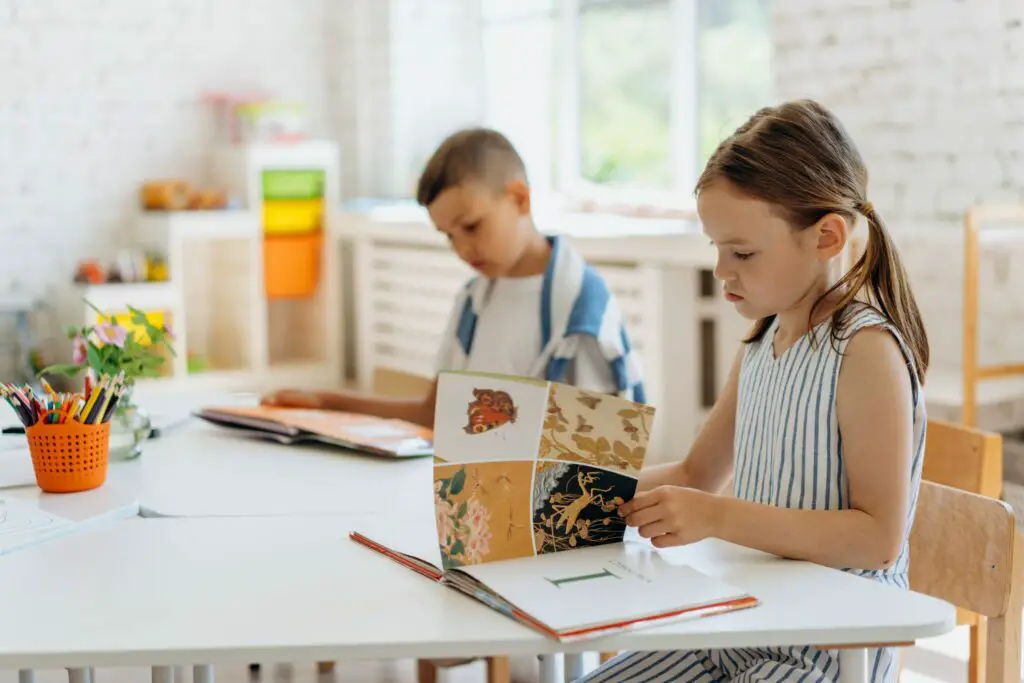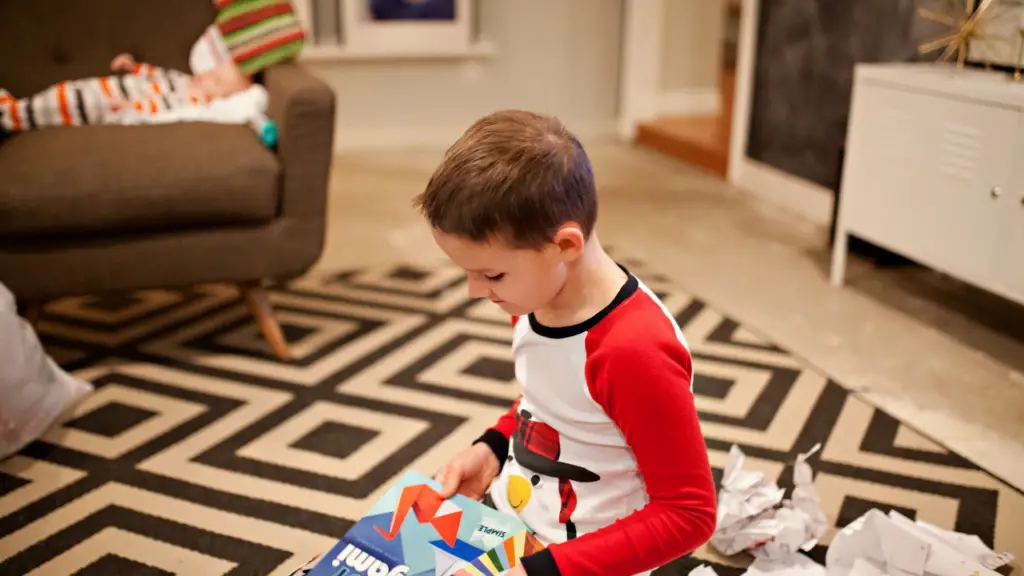Step into the enchanting world of sibling bonding – Fun Reading Activities for Siblings!
From thrilling mystery book swaps to cozying up in reading forts, these captivating activities bring brothers and sisters closer together.
Join us on a journey of imagination, discovery, and shared literary adventures that will create cherished memories and foster a lifelong love for books.
Let’s explore the magic of reading with your siblings, as the joy of storytelling strengthens the unbreakable bond you share.
Reading together can be an exciting and enriching experience for siblings, fostering a strong bond and creating lasting memories.
Here are ten fun reading activities that brothers and sisters can enjoy together.
Some of the links in this post are affiliate links. This means if you click on the link and purchase the item, I will receive an affiliate commision at no extra cost to you. All opinions remain my own. Read more on our Privacy Policy Page

1. Book Exchange – Fun Reading Activities for Siblings
A book exchange is a wonderful way for siblings to share and explore each other’s literary tastes. This activity not only strengthens their bond but also broadens their reading horizons. To start a book exchange, siblings can set up a designated area in their room or home where they display books they are willing to lend to each other.
Here’s how the book exchange can be made more engaging:
Personalized Book Recommendations:
When offering books for exchange, siblings can include personalized notes or recommendations about why they enjoyed the book. This adds a personal touch and makes the reading experience more meaningful. It also encourages the other sibling to give the book a chance, knowing that it comes with a heartfelt recommendation.
Book Reviews and Discussions:
After reading each other’s books, siblings can have mini book club discussions. They can share their thoughts, favorite parts, and discuss how the story impacted them. These discussions open up opportunities for meaningful conversations, allowing them to connect on a deeper level.
Themed Book Exchanges:
To make the book exchange even more exciting, siblings can organize themed exchanges. For example, they can choose a specific genre, author, or time period, and exchange books that fit the theme. This adds an element of surprise and intrigue, as they get to explore a curated selection of books within a particular theme.
Book Exchange with Friends:
Incorporating friends into the book exchange can make it a broader and more diverse experience. Siblings can invite their friends to join the exchange, expanding their reading circle and gaining exposure to a wider range of books and perspectives.
Reading Challenges:
To add an extra layer of fun and motivation, siblings can create reading challenges within the book exchange. They can set goals like reading a certain number of books in a month or reading books from different countries or time periods. Completing these challenges together fosters a sense of camaraderie and accomplishment.
Digital Book Exchanges:
For siblings who are physically separated due to distance or other circumstances, a digital book exchange can be a great alternative. They can use e-book lending platforms or online book clubs to share and discuss their favorite reads virtually.

The book exchange activity not only allows siblings to bond over shared interests but also teaches them the value of generosity and sharing. It encourages them to be open-minded about different genres and authors, expanding their literary horizons. Most importantly, the book exchange creates a sense of community and togetherness, as they embark on a literary journey as partners in crime.
2. Read-aloud Nights – Fun Reading Activities for Siblings
Read-aloud nights are magical moments that bring siblings together through the power of storytelling. This activity involves taking turns reading aloud to each other, sharing the joy of experiencing a story together in real-time. Read-aloud nights are not only fun and entertaining but also have numerous benefits for both younger and older siblings.

Nurturing Bond and Connection:
Read-aloud nights create a special bonding experience as siblings huddle together, sharing the pages of a book. The act of reading aloud fosters a sense of intimacy, allowing them to connect on a deeper level. Younger siblings, in particular, may feel comforted by the presence of their older sibling as they listen to the soothing cadence of their voice.
Improving Reading Skills:
For younger siblings, read-aloud nights provide an excellent opportunity to improve their listening and reading skills. As they hear the words pronounced correctly and see them on the pages simultaneously, they develop better language comprehension and pronunciation.
Cultivating Imagination:
Listening to stories being read aloud sparks the imagination. It transports siblings to far-off lands, introduces them to fantastical characters, and allows them to visualize the story in their minds. This shared imaginative experience enhances creativity and opens up a world of possibilities for both siblings.
Encouraging Expressive Reading:
Reading aloud encourages siblings to experiment with expressive reading, using different tones and voices for various characters. It becomes a performance in itself, and both siblings can take turns putting their own unique spin on the story. This playful approach not only makes the reading more enjoyable but also helps build confidence in public speaking.
Introducing New Literary Gems:
Through read-aloud nights, older siblings can introduce their younger counterparts to literary classics, modern masterpieces, and books they loved growing up. Younger siblings, in turn, can recommend age-appropriate books they think their older sibling might enjoy. This exchange of literary recommendations broadens their reading repertoire.
Discussing Themes and Lessons:
As they progress through a story together, read-aloud nights provide natural breaks for discussions. Siblings can pause to talk about the characters, the plot, and the themes of the book. These discussions offer valuable insights and encourage critical thinking.
Creating Cherished Memories:
Read-aloud nights often become cherished childhood memories. The joy of reading together, the laughter shared over funny characters, or the tears shed during emotional moments forge lasting bonds and a deep appreciation for the time spent together.
Adapting to Different Ages:
Read-aloud nights are versatile and can be adapted to suit siblings of different ages. Younger siblings may enjoy picture books, while older siblings can delve into chapter books or novels. The activity grows with them, and they can continue the tradition throughout their lives.
Time Away from Screens:
In an age dominated by screens, read-aloud nights offer a welcome respite from digital devices. It allows siblings to disconnect from technology and immerse themselves in the simple pleasure of reading and storytelling.
CHECK IT OUT! >>> Bestsellers books for kids on amazon
Instilling a Love for Reading:
Ultimately, read-aloud nights play a crucial role in fostering a love for reading. By sharing stories with each other, siblings develop a passion for literature, a lifelong gift that enriches their minds and souls.
In conclusion, read-aloud nights hold a special place in the hearts of siblings and is Fun Reading Activity for Siblings. They create cherished memories, build connections, and ignite a love for literature that can last a lifetime. So, gather your books, cozy up together, and let the stories transport you to places where imagination knows no bounds.
Proschool Learning Toys for Kid – Educational Busy Book Activities, Montessori Toys Activity Book,Sensory Toy,Toddler Quiet Books,Toddler Girl&Boy Toys for Age 3 4 5 Year Old Tracing Coloring Book

3. Create a Sibling Book Club
Fun Reading Activities for Siblings
Creating a sibling book club is an exciting way for brothers and sisters to embark on a shared literary journey. This activity not only strengthens their bond but also encourages a deeper understanding of each other’s reading preferences and interests. By setting up a book club exclusively for siblings, they establish a private space where they can connect, discuss, and explore the fascinating world of books together.

Selecting Books Together:
The first step in creating a sibling book club is to choose books that appeal to all members. Siblings can take turns suggesting books, and the group can vote on the final selection. It’s essential to be inclusive, considering the different ages, tastes, and reading levels of each sibling.
Setting Reading Goals:
Once the book is chosen, siblings can set reading goals to pace their journey through the book. They can decide on a specific number of chapters or pages to read each week, allowing for meaningful discussions during their club meetings.
Organizing Club Meetings:
Having regular club meetings is crucial for a successful sibling book club. Depending on their availability and preferences, they can meet weekly, bi-weekly, or monthly. During these meetings, siblings can share their thoughts, favorite passages, and ask questions about the book.
Creating Discussion Prompts:
To facilitate engaging discussions, siblings can come up with discussion prompts before each meeting. These prompts can touch on themes, character development, plot twists, and the impact of the story on their emotions and perspectives.
Journaling and Sharing Insights:
Encourage each sibling to keep a journal where they jot down their insights and reflections while reading the book. During the club meetings, they can share their journal entries, fostering meaningful conversations and understanding each other’s interpretations of the story.
Clever Fox Reading Journal – Guided Book Review Log with Reading Tracker

Incorporating Fun Activities:
Make the book club experience even more enjoyable by incorporating fun activities related to the book. Siblings can create fan art, write alternative endings, or even dress up as characters for the meetings.
Inviting Guest Speakers:
To add a unique touch to their book club, siblings can invite guest speakers. This could be a family member, teacher, or author, who can join a meeting to share their insights and experiences related to the book.
Creating a Book Club Library:
As the book club progresses, siblings can create a book club library where they store all the books they have read together. This shared collection becomes a cherished repository of their literary adventures.
Celebrating Book Completions:
When the book club finishes reading a book, siblings can celebrate with a special activity or treat. It could be a movie night featuring the book’s movie adaptation or a themed dinner inspired by the story’s setting or characters.
Exploring Diverse Literature:
To broaden their literary horizons, siblings can make an effort to explore diverse literature. They can choose books from different genres, cultures, or time periods, promoting a deeper understanding of the world around them.
In conclusion, creating a sibling book club is an excellent way to foster a love for reading and create lasting memories. It nurtures a sense of togetherness, encourages communication and critical thinking, and strengthens the unique bond that siblings share. So, gather your siblings, choose a captivating book, and embark on an adventure of reading and discovery together.
4. Build a Reading Fort
Fun Reading Activities for Siblings
Building a reading fort is a delightful and imaginative activity that can turn ordinary reading time into a magical adventure for siblings. A reading fort provides a cozy and enchanting space where they can escape into the world of books and create lasting memories.
>>> Tote A Fort, Blanket Fort Kit, Kids Fort, Kids’ Playhouse

Choosing the Perfect Spot:
The first step in building a reading fort is finding the perfect spot. Siblings can use a corner of their room, a quiet nook, or even a space under a table to create their reading haven. The key is to find a spot that offers comfort and privacy.
Gathering Materials:
Once the spot is chosen, it’s time to gather materials for the fort. Blankets, pillows, and cushions are essential for creating a comfortable reading area. Siblings can also add fairy lights or battery-operated candles to give the fort a magical ambiance.
Building the Fort:
With the materials in hand, siblings can start building the fort. They can drape the blankets over furniture or use chairs to create a tent-like structure. The goal is to create a cozy, enclosed space that feels like a secret reading hideout.
Personalizing the Fort:
To make the reading fort even more special, siblings can personalize it with their favorite decorations and trinkets. They can add posters of their favorite book covers, hang dreamcatchers, or place stuffed animals inside the fort for a touch of whimsy.
Stocking the Fort with Books:
The most important element of the reading fort is, of course, the books! Siblings should gather a selection of their favorite books and stack them inside the fort. They can also include a small basket or shelf with additional books nearby, ensuring they have plenty to read during their fort adventures.
Creating a Reading Ritual:
Once the reading fort is complete, siblings can establish a special reading ritual. They might light the fairy lights, sit inside the fort, and take turns choosing books to read aloud to each other. This ritual sets the tone for a magical and enjoyable reading experience.
Enjoying Snacks and Drinks:
No reading fort is complete without some snacks and drinks. Siblings can bring along their favorite treats like popcorn, cookies, or fruit, along with a thermos of hot cocoa or a refreshing drink.
Imagining New Worlds:
Inside the reading fort, siblings can let their imaginations run wild. They can travel to distant lands, go on daring adventures, and immerse themselves in the lives of the characters they read about.
Creating Fort Memories:
The reading fort becomes a place where siblings can create cherished memories. They might have giggling fits, share secrets, or read each other’s favorite passages, all while enjoying the warmth of the fort they built together.
Inviting Friends and Family:
The reading fort can become a gathering place not only for siblings but also for friends and family. Siblings can invite friends for a cozy reading session or have parents join them for a special family reading time.
In conclusion, building a reading fort is an enchanting and fun activity that brings siblings closer together and makes reading an unforgettable experience. It fosters creativity, ignites the imagination, and provides a space where the magic of books can truly come to life. So, grab some blankets, gather your favorite books, and let your imagination soar within the walls of your very own reading fort.
5. Write Stories Together
Fun Reading Activities for Siblings

Collaboratively writing stories is a fantastic way for siblings to unleash their creativity, embark on imaginative journeys, and strengthen their bond as co-authors. Whether they create fantastical adventures, funny anecdotes, or heartwarming tales, this activity allows siblings to explore their combined storytelling abilities and create something truly unique.

Brainstorming Ideas:
The first step in writing stories together is to brainstorm ideas. Siblings can sit together and throw out different story concepts, characters, and settings. They can build on each other’s ideas, adding twists and turns to create a captivating plot.
Assigning Roles:
Once they have a story idea in mind, siblings can assign roles as co-authors. They may decide to take turns writing paragraphs or chapters, or one sibling can focus on developing the characters while the other handles the plot. Dividing the tasks allows each sibling to contribute their strengths to the story.
The Storymatic Kids – Writing Prompts for Young Writers – Storytelling Games

Creating Engaging Characters:
Building engaging characters is an essential part of any story. Siblings can work together to flesh out their protagonists and antagonists, giving them unique personalities, backstories, and motivations.
Crafting the Plot:
With the characters in place, siblings can work on developing the plot. They can create conflicts, challenges, and plot twists that keep the story exciting and full of surprises.
Editing and Refining:
Writing together also involves editing and refining the story. Siblings can read each other’s contributions, suggest changes, and polish the writing to ensure a cohesive and well-written narrative.
Illustrating the Story:
If they enjoy drawing, siblings can illustrate their story together. Creating accompanying illustrations adds a visual element to the storytelling and brings the characters and settings to life.
Incorporating Each Other’s Ideas:
Collaborative writing allows siblings to incorporate each other’s ideas into the story. This process not only strengthens their bond but also teaches them to be open-minded and receptive to different perspectives.
Exploring Different Genres:
Siblings can experiment with various genres, from fantasy and adventure to mystery and romance. Writing stories in different genres broadens their creative horizons and allows them to explore diverse styles of storytelling.
Sharing Stories with Others:
Once the story is complete, siblings can share it with friends, family, or even create a digital version to share online. Sharing their collaborative work allows them to take pride in their creativity and teamwork.
Preserving the Stories:
Siblings can preserve their collaborative stories by creating a storybook or a digital portfolio. This collection becomes a cherished keepsake of their shared creativity and imagination.
Fun Reading Activities for Siblings
In conclusion, writing stories together is an enjoyable and educational activity that enhances sibling bonding. It fosters creativity, communication, and cooperation, as siblings work together to weave tales that captivate both their hearts and minds. So, grab a pen and paper, or open a blank document, and let your imaginations flow as you embark on a journey of storytelling together.
6. Act Out Scenes
Fun Reading Activities for Siblings
Acting out scenes from books is a delightful and interactive way for siblings to bring their favorite stories to life. This imaginative activity allows them to step into the shoes of beloved characters, immerse themselves in the story’s world, and experience the magic of literature in a whole new way.
Check out! >>> Costumes for Kids on amazon

Choosing the Scene:
The first step in acting out scenes is to choose a favorite scene from the book they are reading. It could be an exciting action sequence, a touching emotional moment, or a humorous dialogue between characters.
Soyoekbt Girls Unicorn Costume LED Light

Assigning Roles:
Once the scene is selected, siblings can assign roles to each other based on the characters involved. They can take turns playing different characters or assign roles according to their preferences.
Creating Simple Props:
To enhance the experience, siblings can create simple props to represent elements from the scene. It could be as basic as using household items to mimic swords or wands, or using scarves as costumes.

Setting the Stage:
Siblings can designate a specific area as their stage, whether it’s in their living room, backyard, or even a local park. The setting should match the scene they are acting out.
Practicing Dialogue:
Before the actual performance, siblings can practice the dialogue and actions of their characters. This rehearsal ensures that they are comfortable with their roles and adds to the overall enjoyment of the performance.
Adding Theatrical Elements:
Acting out scenes is a chance to get creative with theatrical elements. Siblings can experiment with different voices, accents, and expressions to make the characters come alive.
Incorporating Sound Effects:
To make the performance more immersive, siblings can incorporate sound effects. They can clap, stomp, or use simple objects to create sounds that match the scene’s setting.
Filming the Performance:
For an extra touch, siblings can film their performance. This allows them to watch and relive the scene later, capturing their creativity and effort on camera.
Sharing with Family and Friends:
After the performance, siblings can invite family and friends to watch their act. It can be a small private showing at home or even a virtual performance shared over video calls.
Encouraging Improvisation:
Acting out scenes encourages improvisation and creative thinking. Siblings can add their own twist to the scene or explore alternative outcomes, making the experience even more enjoyable.
Building Confidence:
Acting out scenes helps build confidence in both acting and public speaking. It gives siblings an opportunity to express themselves and perform in a safe and supportive environment.
Check out! >>> Costumes for Kids on amazon
In conclusion, acting out scenes from books is a delightful activity that combines the joy of reading with the magic of theatrical play. It allows siblings to explore literature in a dynamic and interactive way, fostering creativity, communication, and a deeper appreciation for the stories they love. So, grab your scripts and costumes, and let your imagination take center stage as you act out the scenes that have captured your hearts.
7. Reading Challenges – Fun Reading Activities for Siblings
Reading challenges are an exciting way for siblings to push their reading boundaries, discover new books, and motivate each other to read more. These challenges set specific goals and milestones, encouraging siblings to explore different genres, authors, and themes, and turning their reading journey into a thrilling adventure.

Setting Personal Goals:
The first step in reading challenges is for each sibling to set their personal reading goals. They can decide how many books they want to read in a specific timeframe, such as a month, a season, or a year.
Creating a Challenge Calendar:
To keep track of their progress, siblings can create a challenge calendar. They can mark the start and end dates of the challenge and keep a log of the books they read along with the dates they completed them.
Exploring Diverse Genres:
Reading challenges encourage siblings to step out of their comfort zones and explore diverse genres. They can choose books from genres they haven’t read before, such as fantasy, mystery, science fiction, historical fiction, non-fiction, or poetry.
Discovering New Authors:
In addition to exploring genres, reading challenges prompt siblings to discover new authors. They can pick books by writers they have never read before, opening themselves up to fresh perspectives and writing styles.
Reading Together vs. Competing:
Siblings can approach reading challenges in two ways. They can read together, sharing their progress and discussing the books they read. Alternatively, they can turn the challenge into a friendly competition, aiming to see who reads the most books within the set timeframe.
Book Recommendations:
As they progress through the challenge, siblings can recommend books to each other based on their preferences and interests. This exchange of recommendations enriches their reading journey and creates a sense of camaraderie.
Public Library Visits:
Reading challenges offer a perfect opportunity for siblings to visit their local public library. They can explore the library’s collection, attend book-related events, and engage with other readers in the community.
Celebrating Milestones:
When siblings reach specific milestones in their reading challenge, they can celebrate their achievements. It could be a simple treat, a book-related gift, or a special outing to the bookstore or library.
Journaling About Reads:
Encourage siblings to keep a reading journal throughout the challenge. They can jot down their thoughts, favorite quotes, and reflections on the books they read. This journal becomes a treasure trove of memories and insights from their reading journey.
Engaging in Discussions:
As they progress through the challenge, siblings can have regular book club-style discussions about the books they read. These discussions encourage critical thinking, analytical skills, and a deeper appreciation for literature.
Rewarding Reading Efforts:
Regardless of the outcome of the challenge, it’s essential to reward the reading efforts of each sibling. The focus should be on the joy of reading and the knowledge gained from exploring new books and ideas.
In conclusion, reading challenges are an exciting way for siblings to embark on a shared reading adventure. They provide an opportunity for personal growth, exploration, and mutual support. By setting and achieving reading goals together, siblings foster a love for books and create lasting memories of their shared reading journey. So, challenge yourselves, dive into the world of literature, and let the books take you on an unforgettable ride.
8. Book-to-Movie Night – Fun Reading Activities for Siblings
Book-to-movie night is a delightful activity where siblings can experience the magic of literature coming to life on the screen. This activity combines the joy of reading with the visual storytelling of movies, making it a perfect way to bond over beloved stories and engage in lively discussions about adaptations.

Choosing the Book and Movie Pairing:
The first step in book-to-movie night is choosing a book and its corresponding movie adaptation. Siblings can take turns selecting their favorite book or mutually decide on a title they both want to explore together.
Reading the Book First:
To fully immerse themselves in the story, siblings should read the book before watching the movie. Reading the book allows them to form their own mental images of the characters and settings, making the movie viewing experience even more intriguing.
Creating a Movie Night Atmosphere:
Siblings can create a cozy and fun movie night atmosphere. They can dim the lights, gather blankets and pillows, and set up a bowl of popcorn or other favorite movie snacks.
Comparing the Book and Movie:
After watching the movie, siblings can have a discussion comparing the book to its adaptation. They can talk about what they liked or disliked about the movie and how it differed from the book.
Exploring Adaptation Choices:
Discussing the adaptation choices provides a chance for siblings to analyze how the filmmakers brought the book to life on the screen. They can talk about the casting, screenplay, and any changes made to the plot.
Highlighting Key Scenes:
Siblings can point out their favorite scenes from the book that made it into the movie and share their thoughts on how well those scenes were translated to the screen.
Identifying Omissions or Changes:
During the discussion, siblings may identify scenes, characters, or plotlines that were omitted or altered in the movie. This opens up opportunities to consider the creative decisions behind those changes.
Appreciating Different Storytelling Mediums:
Book-to-movie night allows siblings to appreciate the unique storytelling strengths of both books and movies. They can discuss how books offer more detailed insights into characters’ thoughts, while movies can create stunning visuals and captivating soundtracks.
Researching Behind-the-Scenes:
To deepen their understanding of the adaptation process, siblings can research interviews or articles about the making of the movie. Learning about the director’s vision and the challenges faced during production adds new layers to their appreciation of the film.
Alternate Endings and “What Ifs”:
As a fun exercise, siblings can explore alternate endings or “what if” scenarios for the story. They can discuss how different choices could have impacted the narrative.
Celebrating the Story Together:
Regardless of their opinions on the movie adaptation, the focus should be on celebrating the story they both love. The shared experience of reading the book and watching the movie becomes a cherished memory.
In conclusion, book-to-movie night is a wonderful way for siblings to enjoy the best of both worlds: the depth of storytelling in books and the visual spectacle of movies. Through discussions and comparisons, siblings gain a deeper appreciation for the creative process and storytelling choices. So, grab your favorite book and its movie adaptation, and let the magic of literature and cinema unfold in the comfort of your own movie night.
9. Start a Book Journal
Fun Reading Activities for Siblings
Starting a book journal is a fantastic way for siblings to record their reading experiences, capture their thoughts on books, and create a personalized literary treasure trove. This activity not only encourages regular reading but also enhances critical thinking and introspection as siblings reflect on the stories they encounter.


Selecting a Journal:
The first step in starting a book journal is selecting a journal that appeals to each sibling. They can choose from a variety of notebooks, diaries, or even create a digital journal if they prefer.
Recording Reading Details:
In their book journal, siblings can record essential reading details such as the title, author, publication date, and genre of each book they read. This creates a comprehensive reading log they can refer back to later.
Writing Book Summaries:
For each book they read, siblings can write brief summaries or synopses. Summarizing the plot helps them consolidate their understanding of the story and characters.
Expressing Opinions and Emotions:
The book journal provides a safe space for siblings to express their opinions and emotions about the books they read. They can share what they loved or didn’t like, how the story made them feel, and any lessons or insights they gained.
Favorite Quotes and Passages:
Siblings can write down their favorite quotes and passages from each book. These quotes can be thought-provoking, inspiring, or even humorous, and they serve as memorable highlights of their reading experience.
Rating System:
To make reviewing books easier, siblings can create a rating system. They can use stars, emojis, or any other symbols to rate each book based on their enjoyment or appreciation.
Tracking Reading Progress:
The book journal allows siblings to track their reading progress over time. They can set reading goals and see how close they are to achieving them as they record new books in their journal.
Book Recommendations:
As they share their book journals, siblings can recommend books to each other based on their reviews and ratings. This exchange of recommendations enhances their reading journey.
Comparing Opinions:
When siblings read the same book, they can compare their opinions and thoughts in their respective journals. This comparison can lead to interesting discussions and insights.
Reflections and Growth:
The book journal becomes a reflection of each sibling’s reading journey and growth over time. They can look back on their earlier entries and see how their tastes and perspectives have evolved.
Preserving Literary Memories:
Perhaps the most precious aspect of the book journal is that it preserves literary memories for years to come. Siblings can revisit their journals in the future, reliving the stories and emotions they experienced while reading each book.
In conclusion, starting a book journal is a delightful and meaningful activity that enhances the reading experience for siblings. It cultivates a love for writing, encourages thoughtful reading, and creates a unique record of their literary adventures. So, grab a journal and a pen, and begin your journey of reading, reflecting, and creating a literary legacy that will stay with you throughout your lives.
10. Mystery Book Swap
Fun Reading Activities for Siblings
The mystery book swap is an exciting and suspenseful activity that adds an element of surprise to the sibling reading experience. This activity involves exchanging mystery books without revealing the titles, allowing siblings to immerse themselves in the unknown and discover new stories together.

Choosing the Mystery Books:
To begin the mystery book swap, each sibling selects a mystery book they believe the other would enjoy. The key is to keep the title and author a secret, creating an air of anticipation and curiosity.
Wrapping the Books:
Once the mystery books are chosen, siblings wrap them in decorative paper or cover them in brown paper bags, adding to the excitement of unwrapping and discovering the hidden gem inside.
Writing Clues or Hints:
To add an extra layer of fun, siblings can write clues or hints about the book on the outside of the wrapped package. These hints can be vague or cryptic, sparking intrigue and making the guessing game even more engaging.
Unwrapping the Mystery:
On the designated mystery book swap day, siblings gather together to exchange their wrapped books. They can take turns unwrapping the packages and revealing the mysterious books they received.
Reading and Discussing:
Once the books are unwrapped, siblings dive into their mystery reads simultaneously. As they progress through the books, they can discuss their theories, share their guesses about the plot, and speculate on the mysteries that unfold.
Guessing the Title:
Throughout the reading process, siblings can make educated guesses about the title and author of the mystery book they received. They can base their guesses on the clues provided or their knowledge of each other’s reading preferences.
Unveiling the Titles:
At the end of the mystery book swap, siblings unveil the titles and authors of the books they selected for each other. This moment of revelation sparks lively conversations about the choices made and the surprises encountered in the mystery books.
Discovering New Authors:
The mystery book swap is an excellent opportunity for siblings to discover new authors they may not have come across otherwise. The activity broadens their reading horizons and introduces them to fresh voices in the mystery genre.
Building Trust and Connection:
The mystery book swap builds trust and connection between siblings as they select books for each other based on their interests and preferences. It shows that they know and understand each other’s tastes.
Creating Lasting Memories:
The mystery book swap becomes a cherished memory for siblings as they reminisce about the surprises, the discoveries, and the joy of sharing their love for books in this unique way.
Continuing the Tradition:
The mystery book swap can become a delightful tradition for siblings. They can make it an annual or seasonal event, continuing to surprise each other with mystery reads and fostering a lifelong appreciation for the genre.
Fun Reading Activities for Siblings
In conclusion, the mystery book swap is an engaging and entertaining activity that adds an element of surprise and adventure to the sibling reading experience. It fosters curiosity, strengthens their bond, and introduces them to new books and authors. So, wrap up your mystery books, share the intrigue with your siblings, and embark on a reading journey filled with suspense and surprises.
Conclusion – Fun Reading Activities for Siblings
Reading together strengthens the bond between siblings, creating cherished memories and a lifelong love for literature.
From building reading forts to exploring mystery book swaps, these activities foster creativity, communication, and empathy.
So, grab a book, cozy up with your sibling, and embark on a magical reading journey together.
Let the power of stories bring you closer and forge an unbreakable sibling bond that lasts a lifetime. Happy reading!







Pingback: Sharing is Caring: How to Encourage Children to Share - SiblingVibes